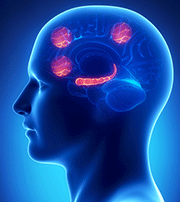Yina Ma, Ph.D., a research scientist at Johns Hopkins' Lieber Institute for Brain Development,...
Brain Scans Reveal Changes Linked to PMDD
 |
So reports Karen Berman, M.D., and Peter J. Schmidt, M.D., of the National Institute of Mental Health Intramural Research Program, and their colleagues in AJP in Advance. It thus looks as though the dorsolateral prefrontal cortex "plays an important role in PMDD," they conclude.
"PMDD is not a diagnosis without controversy in women's mental health circles," Claudia Reardon, M.D., an assistant professor of psychiatry at the University of Wisconsin and an expert on women's issues, told Psychiatric News. "Studies like this that start to look at objective data will hopefully help us move toward a more informed understanding of the nature of the underlying dysfunction."
Researchers have also linked specific variants in an estrogen receptor gene to PMDD. See Psychiatric News.
(Image: CLIPAREA/Custom media/Shutterstock.com)





